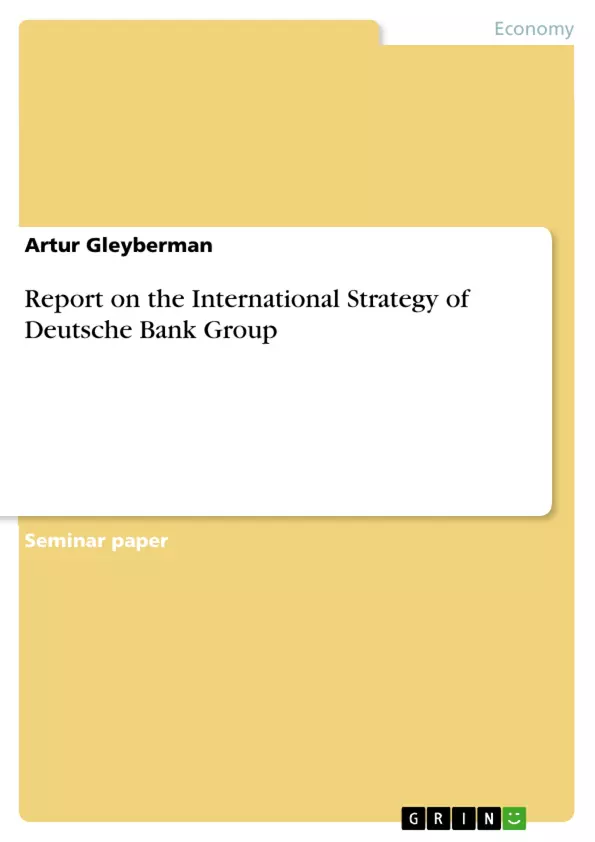This report critically evaluates Deutsche Banks’ (DB) international strategy and business environment, concentrating on DB’s universal bank strategy inside the European region. DB’s international business environment is analysed through the application of PEST Analysis and Porters 5 Forces frameworks. Analysis of DB’s international strategy includes evaluation of DB’s strategic positioning and orientation, entry strategy and finally measuring strategic performance. The latter is achieved by applying the Balance Scorecard Concept together with the features of SWOT Analysis, finally resulting in several recommendations for improvement of DB’s international operations. The applied business theories and concepts are critically examined in the course of their adoption.
The major finding of the report is that although the highly competitive industrial environment and global financial crisis, DB’s strategic management has: achieved good results in positioning DB as a leader in universal banking in Europe as well as around the world; low efficiency and low profitability relative to its main competitors; suffered high share value losses due to the financial crisis as well as its own failures in risk management, but remained stable and credible backed by its strong global franchise. Given that, DB has a strong potential to learn from the crisis, improve its former failures and come out stronger from this crisis.
Inhaltsverzeichnis (Table of Contents)
- Abstract
- 1. Introduction
- 1.1. Scope
- 1.2. DB Profile
- 2. Environmental analysis
- 2.1. PEST Analysis
- 2.1.1. Political and Legal factors
- 2.1.2. Economic factors
- 2.1.3. Social factors
- 2.1.4. Technological factors
- 2.2. Porter's 5 Forces
- 2.2.1. Entrants
- 2.2.2. Industry rivalry and Substitutes
- 2.2.3. Suppliers' and Customers' Power
- 3. Strategy analysis
- 3.1. Strategic Positioning & Orientation
- 3.2. Entry strategy
- 4. Measuring Performance
- 4.1.1. Balance Scorecard Concept
- 5. Conclusion
- References
- Appendices
Zielsetzung und Themenschwerpunkte (Objectives and Key Themes)
This report aims to provide a critical evaluation of Deutsche Bank's (DB) international strategy and business environment, with a particular focus on its universal bank strategy within the European region. The report analyzes DB's international business environment through PEST Analysis and Porter's 5 Forces frameworks, and then evaluates DB's international strategy, including its strategic positioning and orientation, entry strategy, and strategic performance. By applying the Balance Scorecard Concept alongside SWOT Analysis, the report identifies areas for improvement in DB's international operations and critically examines the applied business theories and concepts. The report also compares DB's performance to its main competitors and provides recommendations for development.
- Analysis of DB's international business environment
- Evaluation of DB's international strategy, including its strategic positioning, orientation, and entry strategy
- Assessment of DB's strategic performance using the Balance Scorecard Concept and SWOT Analysis
- Comparison of DB's performance to its main competitors
- Recommendations for improvement and development of DB's international operations
Zusammenfassung der Kapitel (Chapter Summaries)
- Chapter 1: Introduction This chapter introduces the financial industry's rapid development in recent decades, highlighting the challenges and opportunities presented by globalization, technological advances, and financial turmoil. It establishes DB as a leading financial MNC with a long history of international banking experience and outlines the report's objectives. The chapter also defines the scope of the report, focusing on DB's universal bank strategy within the European region.
- Chapter 2: Environmental Analysis This chapter analyzes DB's international business environment through PEST Analysis and Porter's 5 Forces framework. It explores the political, economic, social, and technological factors influencing the banking industry, and examines the competitive landscape, including the threat of new entrants, the intensity of rivalry, and the bargaining power of suppliers and customers.
- Chapter 3: Strategy Analysis This chapter delves into DB's international strategy, focusing on its strategic positioning and orientation. It analyzes DB's decision-making process, its competitive advantage, and its entry strategy into new markets. The chapter also examines DB's business model and its core competencies.
- Chapter 4: Measuring Performance This chapter assesses DB's strategic performance using the Balance Scorecard Concept and SWOT Analysis. It evaluates DB's financial performance, customer satisfaction, internal processes, and innovation. The chapter also compares DB's performance to its main competitors and identifies areas for improvement.
Schlüsselwörter (Keywords)
The report focuses on the international strategy of Deutsche Bank, analyzing its business environment and strategic performance. Key concepts include universal banking, globalisation, PEST Analysis, Porter's 5 Forces, strategic positioning, entry strategy, Balance Scorecard Concept, SWOT Analysis, and financial performance.
- Arbeit zitieren
- BA (Hons) Artur Gleyberman (Autor:in), 2009, Report on the International Strategy of Deutsche Bank Group, München, GRIN Verlag, https://www.grin.com/document/143385



